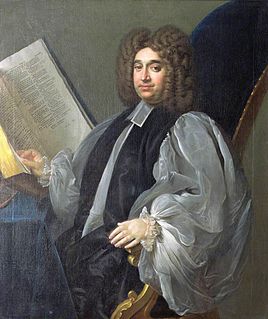Related Research Articles

Robert South was an English churchman who was known for his combative preaching and his Latin poetry.
William Cave was an English divine and patristic scholar.

White Kennett was an English bishop and antiquarian. He was educated at Westminster School and at St Edmund Hall, Oxford, where, while an undergraduate, he published several translations of Latin works, including Erasmus' In Praise of Folly.

Philip Bisse was an English bishop.
Thomas Hayter was an English whig divine, who served as a Church of England bishop for 13 years, and was a royal chaplain. As a party advocate of the Pelhamites and a friend of the Duke of Newcastle, he was at the height of his powers in the 1750s. A scholar renowned in his days, it was for his divinity that Hayter was recommended, but his friendship with the court and royalty that exemplified his actual powers. He was considered tolerant and eclectic, learned and intelligent.
John King was an English churchman, patron of the Church of Pertenhall in Bedfordshire.

Sir John Dodson was an English judge, aka Dean of Arches, and member of parliament.

John Williams was an English Bishop of Chichester.

Thomas Turner was an English royalist churchman and Dean of Canterbury.

William Stanley (1647–1731) was an English churchman and college head, Master of Corpus Christi College, Cambridge, Archdeacon of London and Dean of St Asaph.
Thomas Turner was an English churchman and academic, Archdeacon of Essex and President of Corpus Christi College, Oxford.
Thomas Manningham (1651?-1722) was an English churchman, bishop of Chichester from 1709.

William Bradshaw was a Welsh churchman, who in the course of his career served as Dean of Christ Church, Oxford, and Bishop of Bristol.
Philip Bearcroft, D.D. was an English clergyman and antiquary.
Richard West (1670?–1716) was an English churchman and academic, and was archdeacon of Berkshire from 1710.
Adam Littleton (1627–1694) was an English cleric and lexicographer.
Edward Lawrence or Laurence was an English ejected minister.
William Payne (1650–1696) was an English academic and cleric of the Church of England, known as a controversialist.

Benjamin Woodroffe (1638–1711) was an English cleric and college head.
Nathaniel Resbury (1643–1711) was an English cleric and author.
References
- ↑ "Clergy of the Church of England Database 1540-1835" . Retrieved 9 August 2020.
- ↑ Foster, Joseph (1891). Alumni Oxoniensis: the members of the University of Oxford, 1500-1714 : their parentage, birthplace, and year of birth, with a record of their degrees. Being the matriculation register of the University alphabetically arranged, revised and annotated; vol 4: early series. London: Parker. p. 1627.
- ↑ Stenning, Alan Herbert; Barker, G. F. Russell (1928). The Record of Old Westminsters: a Biographical List of All Those Who Are Known to Have Been Educated At Westminster School From the Earliest Times to 1927. Vol. 2. London: Printed at the Chiswick Press. p. 992.
- ↑ Foster, Joseph (1891). Alumni Oxoniensis: the members of the University of Oxford, 1500-1714 : their parentage, birthplace, and year of birth, with a record of their degrees. Being the matriculation register of the University alphabetically arranged, revised and annotated; vol 4: early series. London: Parker. p. 1627.
- ↑ Faulkner, Thomas (1820). History and antiquities of Kensington, interspersed with biographical anecdotes of royal and distinguished personages, and a descriptive catalogue of the collection of pictures in the palace. London. p. 363.
- ↑ Wigan, William (1695). "Will of William Wigan, Vicar of Kensington, Middlesex, dated 10 September 1695, codicil dated 26 September 1699 and proved 3 May 1700, PROB 11/455/298". National Archives. Retrieved 13 August 2020.
- ↑ Faulkner, Thomas (1820). History and antiquities of Kensington, interspersed with biographical anecdotes of royal and distinguished personages, and a descriptive catalogue of the collection of pictures in the palace. London. pp. 144–145.
- ↑ Faulkner, Thomas (1820). History and antiquities of Kensington, interspersed with biographical anecdotes of royal and distinguished personages, and a descriptive catalogue of the collection of pictures in the palace. London. pp. 144–145.
- ↑ Wigan, William (1717). A sermon preached before the King and Queen at White-hall, on Sunday, Jan. 8. 1692/3 / By William Wigan, chaplain to Their Majesties. Published by Their Majesties special command. London: printed by R. Norton for Walter Kettilby, at the Bishop's Head in St. Paul's Church-Yard.
- ↑ Wigan, William (1697). A funeral sermon preach'd on the decease of the Right Honourable the Lady Elizabeth Cutts, late wife of the Right Honourable the Lord Cutts, on the 5th of December, 1697. at Kensington-Church / by William Wigan, chaplin in ordinary to His Majesty, and vicar of Kensington. ESTC: R19988. London: Printed for Walter Kettilby, at the Bishop's-Head in S. Pauls Church-yard.